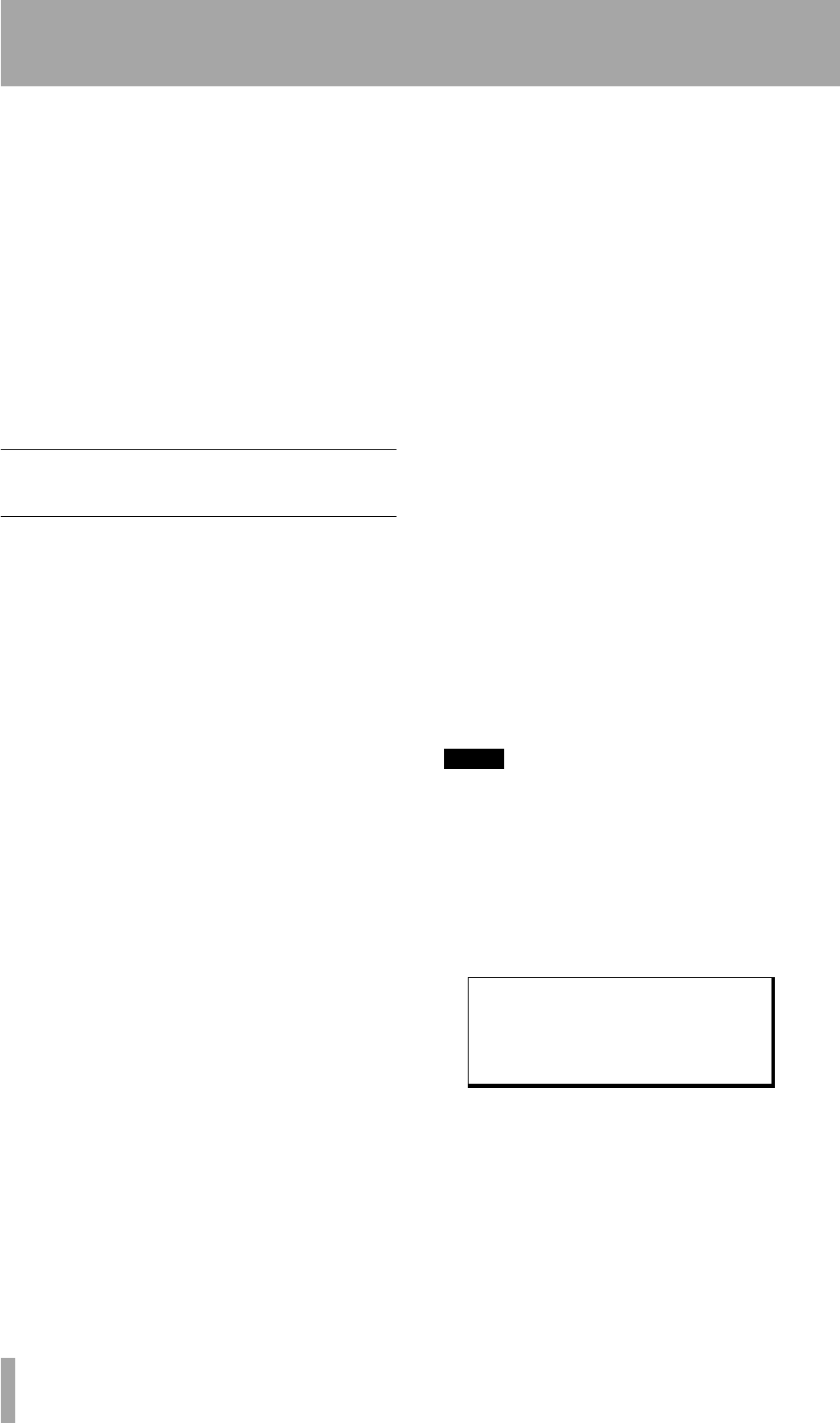
56 TASCAM DA-98HR
9 – Operations related to timecode
The DA-98HR contains synchronization facilities,
including a timecode generator, which allow it to act
either as a timecode master or a timecode slave.
If timecode is recorded, a special discrete subcode
track is used, leaving all eight tracks free for record-
ing and playback of audio material.
However, the DA-98HR is able to synchronize with
external timecode devices, even if the DA-98HR tape
has not been striped, by converting its internal servo
subcode (ABS) to timecode “on-the-fly”. We refer to
this as “synthesizing” timecode.
A full range of options is provided for full compati-
bility with the widest possible range of equipment.
9.1 ABS and SMPTE/EBU
timecode
In some menus, by the time value, you may see either
ABS or TC. Here, we explain these two different
timing reference methods and the differences
between them.
9.1.1 ABS time
“ABS” stands for “Absolute”, and is the absolute
time of the tape as recorded on the subcode of the
tape. This timing starts at the beginning of the tape
with a value of 00:00:00:00. This is the timing refer-
ence used when the DA-98HR is not using SMPTE/
EBU timecode.
Timecode (whether SMPTE or EBU) contains a fixed
number of frames per second. However, the ABS
method of timing works in a slightly different way.
In three seconds of time, there are 100 frames. These
frames are allocated as follows:
This pattern is repeated every three seconds, as you
will notice when you set frame values using the menu
system in ABS mode. When multiple DTRS units are
connected together in DTRS sync mode, the master
unit always outputs ABS timings to the slave unit(s).
9.1.2 Tape timecode
“TC” stands for timecode, and is shown whenever a
SMPTE/EBU timecode value is used rather than the
ABS value.
The timecode may be internally generated or
received from an external source. It can be SMPTE/
EBU, received and transmitted via the
TIME CODE
IN/OUT
connectors l, or it can be SMPTE/EBU
timecode synthesized from the ABS subcode (9.2,
“Tape timecode mode”).
Whether the SMPTE/EBU timecode is generated or
synthesized, we will refer to it as “timecode” in this
manual, to distinguish it from ABS timing values.
SMPTE/EBU timecode can be re-produced indepen-
dently of ABS timings and can be of any frame for-
mat supported by common timecode standards.
When multiple DTRS units are connected, and the
master unit’s
CHASE mode is set on, the master will
chase to any incoming timecode, regardless of
whether timecode or ABS timings have been selected
as the time mode (9.1.3, “Selecting TC or ABS tim-
ing” below).
Timing information received and transmitted from
and to external controllers (e.g. RS-422, MIDI or
Bus) will always be referenced to timecode values.
When the DA-98HR is referenced to its absolute
timecode, the
ABS indicator to the left of the tape
counter will light, and when referenced to timecode
(internal or external), the
TC indicator will light.
9.1.3 Selecting TC or ABS timing
NOTE
This procedure is fundamental to synchronization opera-
tions. If you select the ABS timing mode when you want to
synchronize with timecode, you will be unable to synchro-
nize the DA-98HR.
To change between the two different time reference
modes, perform the following procedure:
1 Go to menu group 3, move the cursor to
TimeMode and press ENTER.
2 Use the § and ¶ keys to select either
ABS
(absolute) or
TC (timecode).
The appropriate indicator to the left of the
tape counter (either
ABS or TC) will light.
Second
Number of
frames
Maximum frame value
displayed
00 – 01 33
32
01 – 02 33
32
02 – 03 34
33
Time Mode
ABS


















